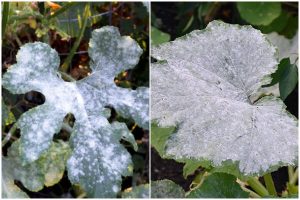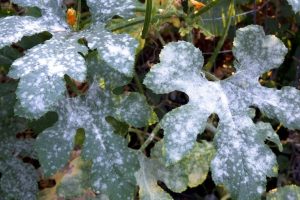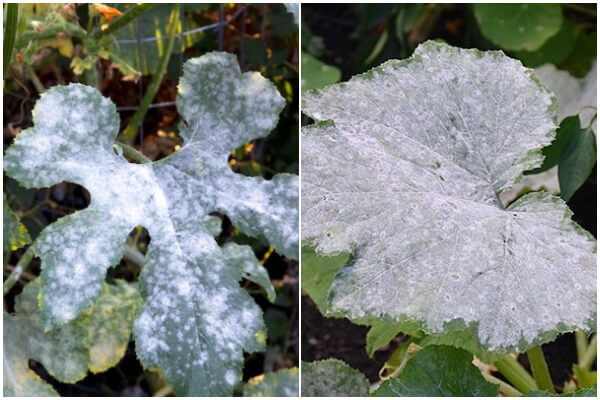Powdery mildew is one of the most common fungal diseases that can affect vegetable gardens. Characterized by a white, powdery substance that coats the leaves, stems, and even fruits of plants, this disease thrives in warm, humid environments. It’s a significant concern for gardeners, as it can weaken plants, reduce yields, and diminish the overall health of the garden. Fortunately, there are several homemade and natural methods to manage and prevent powdery mildew without resorting to synthetic chemicals. Let’s explore these solutions in detail.

What Causes Powdery Mildew?
Powdery mildew is caused by various species of fungi, with each species targeting specific plants. Unlike many fungal diseases, it doesn’t require water to germinate; instead, it thrives in humid conditions with moderate temperatures, typically between 60°F and 80°F (15°C to 27°C). Poor air circulation, crowded plants, and shady conditions further encourage its growth.
Recognizing the symptoms early is crucial. Look for:
- White, powdery spots on leaves, stems, and flowers.
- Distorted or stunted growth in plants.
- Yellowing and premature leaf drop.
Addressing powdery mildew promptly can prevent it from spreading and damaging your vegetable garden.
Top Homemade Treatments for Powdery Mildew

1. Baking Soda Solution
Baking soda (sodium bicarbonate) is a proven remedy for controlling powdery mildew. It works by altering the pH on the leaf surface, making it inhospitable for fungal growth.
How to Prepare:
- Mix 1 tablespoon of baking soda with 1 gallon of water.
- Add 2 tablespoons of horticultural oil or liquid soap to act as a surfactant, helping the solution adhere to leaves.
How to Apply:
- Spray the solution on affected plants, covering all surfaces, including the undersides of leaves.
- Reapply weekly or after rainfall.
Pro Tip: Conduct a patch test on a single leaf to ensure the plant isn’t sensitive to the solution.
2. Milk Spray
Milk is a surprisingly effective treatment for powdery mildew. Researchers suggest that milk proteins create an antiseptic effect when exposed to sunlight, inhibiting fungal growth.
How to Prepare:
- Dilute milk (raw, skim, or whole) with water in a 1:2 or 1:3 ratio.
How to Apply:
- Spray the mixture on plants once a week, ensuring even coverage.
- Use during the early morning to allow the milk to dry before evening.
This method works particularly well on cucumbers, squash, and melons.
3. Neem Oil
Neem oil is a natural fungicide extracted from the seeds of the neem tree. It not only controls powdery mildew but also repels pests such as aphids and whiteflies.
How to Use:
- Mix neem oil with water according to the label’s instructions (typically 1 to 2 tablespoons per gallon of water).
- Spray the solution on affected plants, ensuring thorough coverage.
Frequency:
- Apply every 7 to 14 days, preferably in the evening or early morning to prevent sunburn on leaves.
Note: Avoid spraying neem oil in temperatures above 90°F (32°C) as it may harm plants.
4. Garlic Extract
Garlic contains sulfur compounds that are naturally antifungal, making it an excellent remedy for powdery mildew.
How to Prepare:
- Blend 2 bulbs of garlic with 1 quart of water.
- Strain the mixture through cheesecloth to remove solids.
- Dilute the concentrate by adding 1 gallon of water.
How to Apply:
- Spray on affected plants every 7 to 10 days.
Garlic sprays are eco-friendly and biodegradable, posing no harm to beneficial insects.
5. Apple Cider Vinegar Spray
The acidity of apple cider vinegar can help kill powdery mildew spores and prevent their spread.
How to Prepare:
- Mix 2 to 3 tablespoons of apple cider vinegar (5% acidity) with 1 gallon of water.
How to Apply:
- Spray the solution on affected plants during the early morning.
- Repeat every 7 days for consistent results.
Warning: Avoid over-concentrating the vinegar, as excessive acidity can harm plant tissues.
Preventive Cultural Practices
Prevention is always better than cure. Implementing the following cultural practices can reduce the likelihood of powdery mildew in your vegetable garden:
1. Proper Spacing and Pruning
- Space plants appropriately to improve air circulation.
- Regularly prune dense foliage to reduce humidity around plants.
2. Choose Resistant Varieties
- Opt for vegetable varieties bred for resistance to powdery mildew. For example, certain squash and cucumber cultivars are more tolerant.
3. Watering Practices
- Use drip irrigation or water plants at the base to keep foliage dry.
- Water early in the day to allow moisture to evaporate quickly.
4. Maintain Garden Cleanliness
- Remove and dispose of infected leaves and plant debris.
- Avoid composting infected material, as it can reintroduce the fungus.
5. Crop Rotation
- Rotate crops yearly to minimize the buildup of powdery mildew pathogens in the soil.
Homemade treatments are cost-effective, eco-friendly, and safe for your plants, pets, and the environment. By avoiding synthetic fungicides, you also protect beneficial insects, such as pollinators and predatory bugs, which are essential for a thriving garden ecosystem.
Powdery mildew is a persistent issue for vegetable gardeners, but with the right strategies, it’s entirely manageable. By using homemade solutions like baking soda sprays, milk mixtures, neem oil, and garlic extract, you can effectively treat and prevent this fungal disease. Combine these treatments with good gardening practices, such as proper spacing and pruning, and you’ll ensure a healthy and productive vegetable garden.
Keep experimenting with these natural methods to find what works best for your specific garden conditions. A proactive approach will not only control powdery mildew but also foster a sustainable and flourishing gardening experience.

